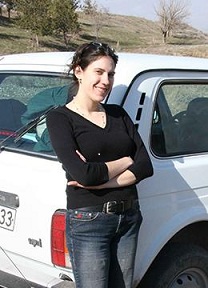Lauren Ristvet has spent most of her career on the edge. As an archeology major, she began her research in Syria, on the periphery of ancient Mesopotamia. After earning her Ph.D., she knew she wanted to work next in the archaeologically underexplored Azerbaijan, once the edge of the Persian Empire. She and her partners are using new isotopic techniques, which measure the distribution of certain isotopes of elements including strontium, oxygen, nitrogen, and carbon in items including seeds and bones, to answer questions like what food an animal ate or where a human came from. By doing this, they are getting a better picture of what life was like on the edge of an empire.
Unlike its Southern Caucasus neighbors Armenia and Georgia, there has been very little digging in Azerbaijan, especially since the fall of the Soviet Empire. “I tried to find every bit of information I could, and used interlibrary loan to get anything from any library in the country,” says Ristvet. “Then I found as many email addresses for Azerbaijani scholars as I could.” She wrote to these potential collaborators in Russian with an English translation at the bottom “because I wasn’t sure if my Russian was actually understandable.”
She had already booked a flight to Azerbaijan when one of her recipients responded. She and Safar Ashurov, of the Institute of Archeology in Baku, spent five days exploring the autonomous republic of Naxçivan, south of the rest of Azerbaijan. Because there had been so little funding for archaeology, Ashurov and his colleague Veli Baxseliyev, head of the Institute of Archeology, were eager to form a partnership.
Working through language barriers and initial culture shock, the team began to excavate the fortress site Oğanqala (“Knight’s Castle”). They discovered unusual sandstone columns, suggesting that the site was a regional capital. They also found several potsherds with cuneiform inscriptions, the oldest evidence of writing ever excavated in Azerbaijan.
Ristvet and her partners are now focusing on the ordinary people who lived in the settlement around the fortress. Analyzing seeds and animal and human bones should open a window to how the people lived and moved: Did they keep animals in barns or pasture them outside? Were the animals born in the area or somewhere else, which would indicate trade with others? “Looking for these markers of movement is really new,” says Ristvet. “I wanted to do a project that tried to look at everything together, to get a really robust idea of how settlement and mobility worked.”
“I think empires often provide opportunities to elites,” she says. “If you’re closer to the imperial core sometimes empires can bring peace and even prosperity. But I’ve been working in regions where you have pretty continuous violence.” In Syria they found that people’s diets became worse over time, and the diets of the elite and the commoners began to diverge. She suspects that they’ll find something similar in Azerbaijan.
“You get a very different idea of empire if you’re looking at it from the frontiers. When you’re in the center, it’s easy to fall victim to what the empire thinks of itself. You’re reading its history; you’re seeing the amazing monuments. But when you’re in the frontiers, you see those day-to-day consequences of empire, and the ways that people are negotiating with the empire. It becomes a messier story.”



